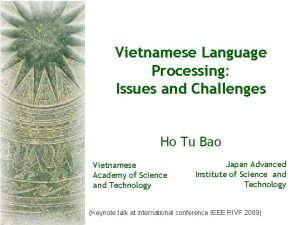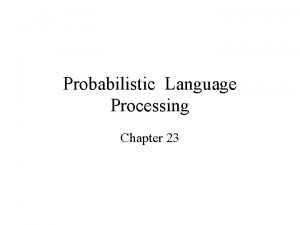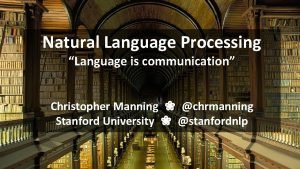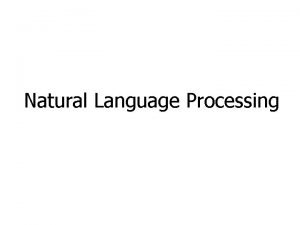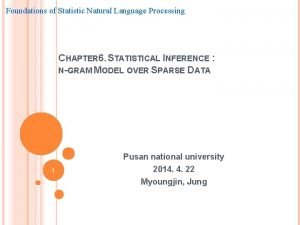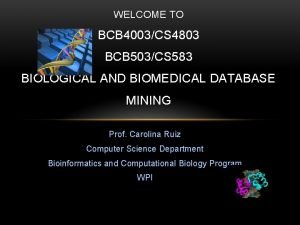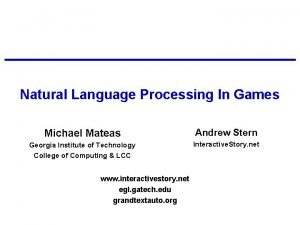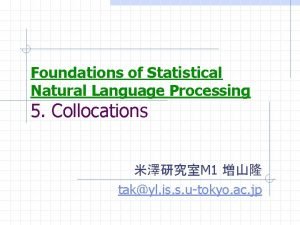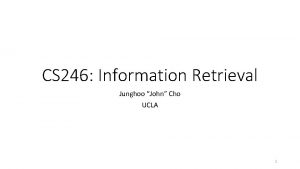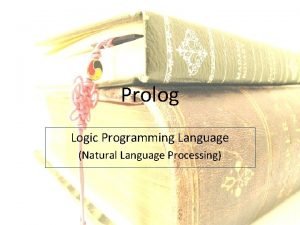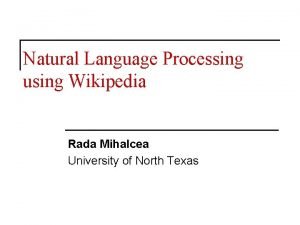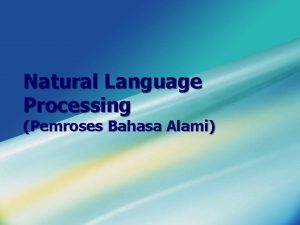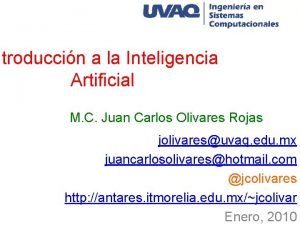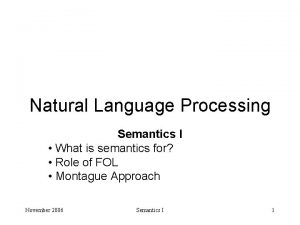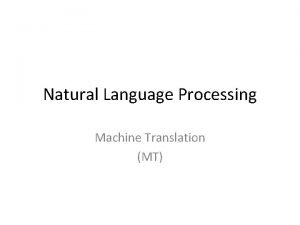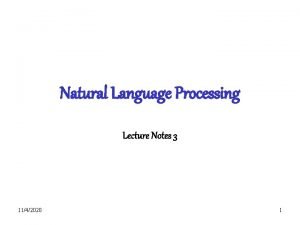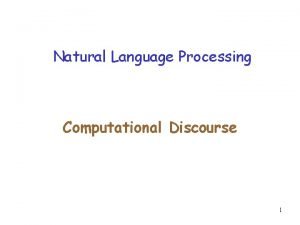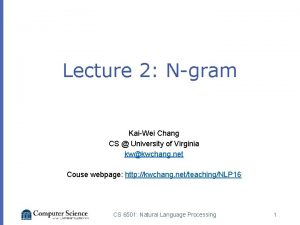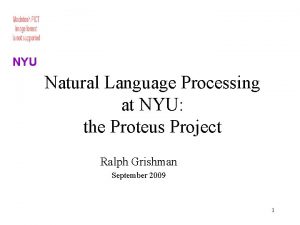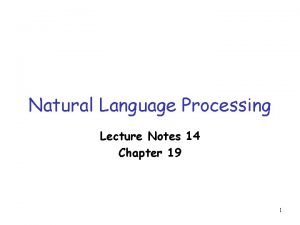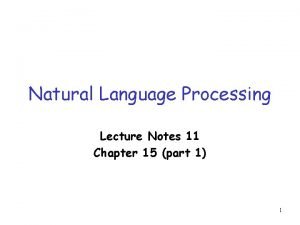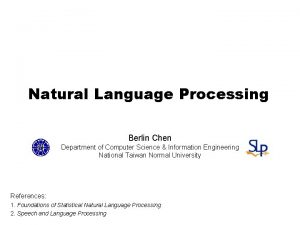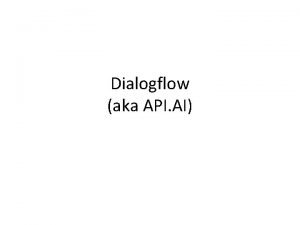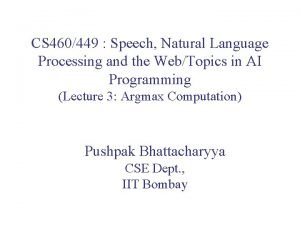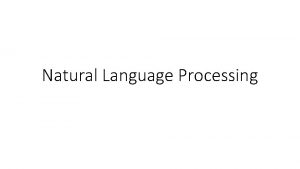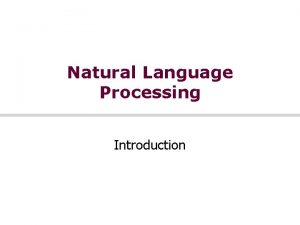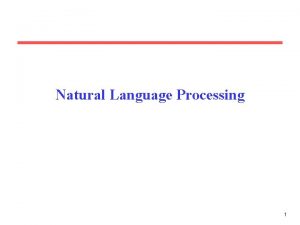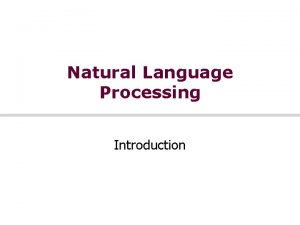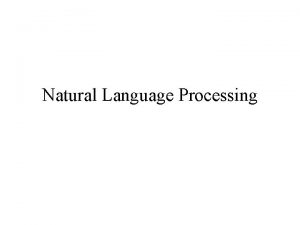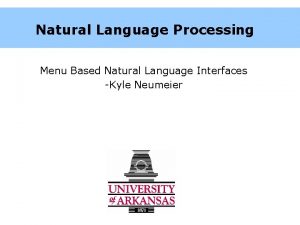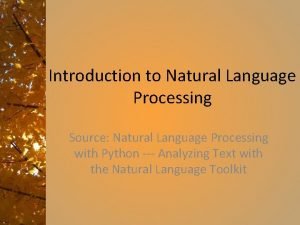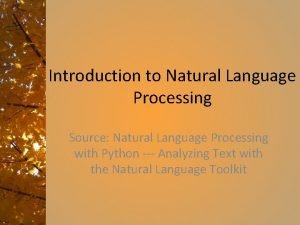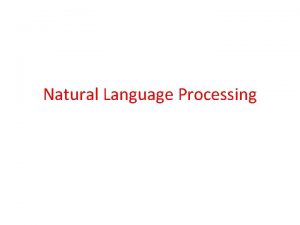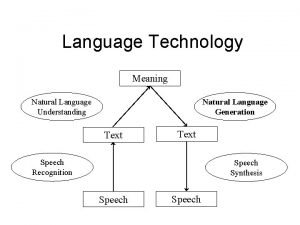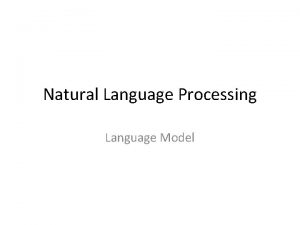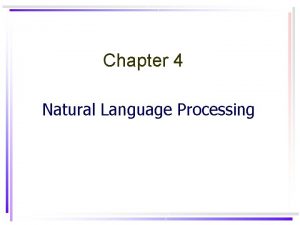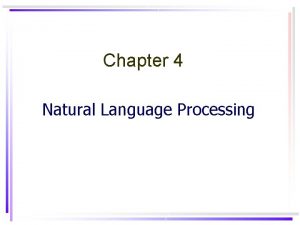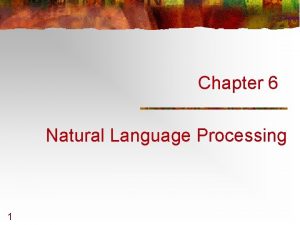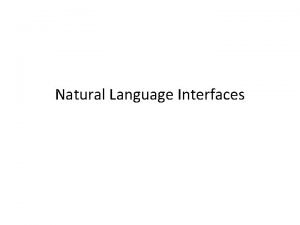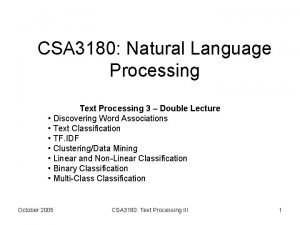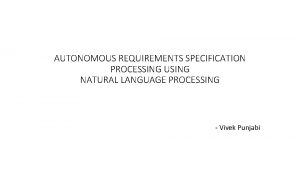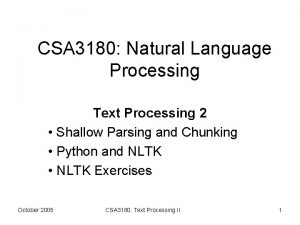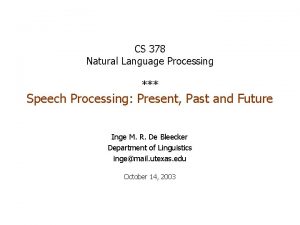CHAPTER 7 Natural Language Processing Natural Language Processing






































- Slides: 38

CHAPTER 7 Natural Language Processing

Natural Language Processing n n Natural language processing is a branch of AI whose goal is to facilitate communication between humans and computers using written (monologue) or oral (dialogue) of the human language Natural language processing consist of two main areas : n Natural language understanding : n n to make computers understand instruction given in natural language Natural language generation : n to make computers generate natural language

Study of Language n n n Language: n Written: Long-term record of knowledge from one generation to another n Spoken: primary mean of coordinating day-to-day behavior with others n Natural (eg. Malay, English) vs. Artificial (Java, Prolog, Coding) Communication n Use sign / natural language/ body language n Sender and Receiver Studied in several disciplines: n Linguist: structure of language n Psycho. Linguists: the process of human language production and comprehension n Philosopher: how words can mean anything & how they identify object in the world, what it means to have belief, goals and intention, cognitive capabilities relate to language n CL: to develop a computational theory of Language (using the notions of algorithm & data structure from CS)

Application of NLU n n It represents the meaning of sentences in some representation language that can be used later for further processing : applications Text-based applications n Written text processing (books, newpaper, reports, manual, email, sms) = reading-based tasks n n n Searching/finding from database of text Extracting information from text Translating documents (MT) Summarizing texts for certain purpose Story understanding

Application of NLU n Dialogue-based applications – involve humanmachine communication (spoken / keyboard/mouse/ recognizer) n n n n Q&A systems, eg. Query database Automated customer service (phone) Tutoring systems (interaction with students) Spoken language control of machine General cooperative problem-solving system Speech recognition <> Language understanding system (only identify the word spoken from a given speech signal, not – how words are used to communicate) Discuss ELIZA system

ELIZA system n n Mid-1960 s, MIT, a Therapist (system) & patient (user), Weizenbaum, 1966 Algorithm: n n n Has a Dbase of particular words (keywords) For each keyword -> store an integer, a pattern to match against the input and a specification of the output Given Sentence(S), find a keyword in S whose pattern matches S If > 1 keyword, pick the one with highest integer value Use the output specification that is associated with this keyword to generate next sentence If there are No keywords, generate an innocuous continuation statement, eg: Tell me more, Go on. (figure 1. 2, 1. 3 Allen)

Flow of Language Analysis n n Natural language understanding follows the following stages n Parsing n Involves the analysis of the syntactic structure of sentences. Parsing determines that a sentence follows the syntactic rules of the language. The output of the parsing stage is a parse tree n Semantic interpretation n Involves the production of a representation (propositions, conceptual graphs, frames) of the meaning of a sentence n Incorporation of world knowledge n Involves the generation of an expanded representation of the sentence’s meaning for the complete understanding of the sentence The output produced could then be used by application systems such as the database query handler, expert system interface, translator and HCI systems.

Flow of Language Analysis 1. Parsing Sentence : Ahmad kicked the ball

Stages of Language Analysis 2. Semantic Interpretation Eg. Sentence : Ahmad kicked the ball

Flow of Language Analysis 3. Incorporation of World Knowledge Sentence : Ahmad kicked the ball

The Different Levels of Language Analysis n n n Phonetics/phonology Knowledge (K)- how words are related to the sounds that realize them Morphology K– how words are constructed from more basic meaning units called morpheme, the primitive unit of meaning in a language Syntactic K– how words can be put together to form correct sentences and determines what structural role each word plays in the sentence and what phrases are subparts (eg. POS) of what other phrases

Levels of Language Analysis cont. n n Semantic K– what words mean (lexical semantics) and how these meanings combine in sentences to form larger meaning, eg. sentence meanings (compositional semantic). Study of context-independent meaning Pragmatic K – concern how sentences are used in different situations and how use affects the interpretation of the sentence (kind of polite and indirect language); Context-dependent meaning. Discourse K- how the immediately preceding sentences affect the interpretation of the next sentence. (pronoun and temporal aspects of information conveyed) World K – includes the general knowledge about the structure of the world that language users must have in order to eg. Maintain a conversation. Includes what each language user must know about the other user’s beliefs and goals (discourse model)

Morphological Analysis n n n The construction of words from more basic components Large vocabulary system has a problem in representing lexicon Reasons: n A large number of words. Word can be formed in 2 ways: n n n Inflectional form : go+es/ne = goes/gone (v -> v) Derivational form : friend + ly = friendly (n -> adj) Open Class words (noun, verb, adj, adv) & Closed class words (articles, pronouns, prepositions)

One Solution n n Preprocess the input sentence into a sequence of morphemes A word may consist of a single morpheme, but often a word consists of a root form plus an affix

Example n The word: goes n n n Root word : go Suffix : es (plural, present tense) Without pre-processing, a lexicon needs to list all the form of go, including: went, going, gone With preprocessing, there would be ONE morpheme go that may combine with suffixes such as –ing, -es, and –en; and ONE entry for the irregular form: went. Thus, the lexicon would only need to store TWO entries (go and went) rather than FOUR. Other examples: eaten, happiest Some word cannot be decomposed into a root form and a suffix. Example is the word seed

Finite State Transducer (FST) n n n A lexicon would have to encode what forms are allowed with each root One famous model is based on FSTs This model is like the Finite State Machines except that they produce an output given an input

FST cont. n n An arc is labeled with a pair of symbols For eg: n An arc labeled i: y ; could only be followed if the current input is the letter i and the output is the letter y n n FST can be used to concisely represents the lexicon and to transform the surface form of words into a sequence of morphemes. Show examples in Allen, pg 71 -72

FST cont. n n Arcs labeled by a single letter have that letter as both input and output FST accepts the appropriate forms and outputs the desired sequence of morphemes The entire lexicon can be encoded as an FST that encodes all the legal words and transforms them into morphemic sequences The different suffixes need only be defined once, and all root forms that allow that suffix can point to the same node

Syntactic Analysis n n Syntactic analysis involves analyzing the structure of a sentence. This would require checking whether the sentence is formed according to a set of syntactic rules – grammar Parsing is an activity that takes a sentence as a set of linguistic token (words) and checks the ordering of the tokens against a grammar. If the sentence is derived from the grammar then parsing yields a parse tree of the sentence

Parsing using context free grammars n n A context free grammar comprises rules that are made up of two types of symbols – terminals and non terminals Non – terminals n n Terms that describe higher-level linguistic concepts such as sentence, noun phrase verb phase. Non terminals need to be further expanded as they may contain other non terminals and terminals Terminals n Terms that are usually individual words. Terminals cannot be further expanded. They never appear on the right of a rule

Parsing using context free grammars n n n Parsing of a sentence begins with the non-terminals symbol sentence at the top of the parse tree Parsing progresses by way of substitutions according to the rules of the grammar. A legal substitution replaces the left-side of a rule with the non-terminal (and terminal) symbols of the right side of the rule. In this case, higher level non-terminal symbols are replaces by lower level non-terminal symbols or terminals. Parsing is terminated when all the lower nodes of the parse tree comprise terminals, i. e. individual words. If the order of the terminals in the parse tree is the same as that of the original sentence when it is said the sentence follows the rules of the language, i. e. is a legal sentence

Parsing a Natural Language Sentence n Consider the grammar : 1. 2. 3. 4. 5. 6. 7. 8. 9. 10. sentence -> noun_phrase verb_phrase noun_phrase -> article noun verb_phrase -> verb noun_phrase article -> the article -> a noun -> man noun ->car verb -> drove

Step 1 n The man drove a car

Step 2 n The man drove a car

Step 3 n The man drove a car

Step 4 n The man drove a car

Parsing a Natural Language Sentence n Derivation of the sentence “the man drove a car” according to the given grammar STRING APPLY RULE # 1. sentence 1 2. noun_phrase verb_phrase 3 3. article 5 noun verb_phrase 4. article noun verb noun_phrase 3 5. article noun verb article 6 noun 6. the noun verb article noun 8 7. the man man verb article noun 10 8. the 9. the drove article the noun 7 noun 9 car Sentence parsed

Representation & Understanding n A crucial component of understanding involves computing a representation of the meaning of sentences and texts. (Reason: Senses & ambiguity)

Representations and Understanding n n Computing a representation of the meaning of sentences and texts (Notion of representation) Why can’t use the sentence itself as a representation of its meaning? Most words have multiple meanings (Senses). eg. Cook, bank, still (verb or noun), n I made her duck. n I saw a man in the park with a telescope Thus, ambiguity inhibit system from making the appropriate inferences needed to model understanding (need to resolve or disambiguate: eg. Use Lexical disambiguation: POS, word-sense disambiguation, ontology) A program must explicitly consider each senses of a word to understand a sentence

n n n Represent meaning: must have a more precise language Mathematics & Logic and the use of formally specified representation languages (formal language) – notion of an atomic symbol Useful representation languages have 2 properties: n n Precise and unambiguous Capture the intuitive structure of the natural language sentences that it represents

Representation n n Syntax – indicates the way that words in the sentence are related to each other The structure illustrates how the words are grouped together into phrases, what words modify what other words and what words are of central importance in the sentence It may identify the types relationships that exist between phrases and can store information about the particular sentence structure that may be needed for later processing Eg: 1. John sold the book to Mary 2. The book was sold to Mary by John

Representation cont. n n n Sentence Structure does not reflect its meaning (although have the same syntactic structure, eg. the catch) The intended meaning of a sentence depends on the situation in which the sentence is produced. Context independent (the logical form, LF) vs. Context dependent

Semantic Analysis: The Logical Form, LF n n n LF = encodes possible word senses and identifies the semantic relationships between the words and phrases Many of the relationships are captured using an abstract set of semantic relationships between the verb and its NP Context Independent Eg: Selling event, John is the seller, the book is the object being sold and Mary is the buyer. These roles are instances of the abstract semantic roles: AGENT, THEME and TO-POSS (final possessor), respectively. Show another example: invite - the ball

The Final Meaning Representation n n The final representation: a general Knowledge Representations language, which is the system uses to represent and reason about its application domain The goal of contextual interpretation is to take a representation of the structure of a sentence and its logical form, and to map this into some expression in the KR that allow the system to perform the appropriate task in the domain. This is the language in which all the specific knowledge based on the application is represented Use FOPC, Semantic Network Eg: Q-A application – a Q might map to a DB; Story Understanding application – a sentence might map into a set of expressions that represent the situation that the sentence describes.

Discourse & Pragmatic Analysis n n Context Dependent Discourse Structure Theory Discourse Relations n Discourse Model n Discourse Structure n n World Knowledge Domain Specific n Corpus n

Discussion n Use the following sentences to understand (to describes) the distinction between syntax, semantics and pragmatics: Language is one of the fundamental aspects of human behavior and is a crucial component of our lives. n Green frogs have large noses. n Green ideas have large noses. n Large have green ideas noses. n

Discuss the following sentences (ambiguity) 1. I made her duck. (5 meanings) 2. I saw a man in the park with a telescope. (2 meanings) n Make your own ambiguous sentences

Bibliography n n n n n ACL (Association for CL) / EACL COLING (int conference of CL) Applied NLP Workshop on Human Language Technology Journal: CL & NLE IEEE ICASSP: Acoustic, Speech and Signal Processing IEEE Transactions on Pattern Analysis and Machine Intelligence IJCAI: Int Joint Conference on AI Journal: AI, Computational Intelligence, Cognitive Science
 Natural language processing vietnamese
Natural language processing vietnamese Probabilistic model natural language processing
Probabilistic model natural language processing Natural language processing nlp - theory lecture
Natural language processing nlp - theory lecture Markov chain natural language processing
Markov chain natural language processing Manning natural language processing
Manning natural language processing Contoh bahasa alami
Contoh bahasa alami Discourse analysis in nlp
Discourse analysis in nlp Nlp lecture notes
Nlp lecture notes Foundations of statistical natural language processing
Foundations of statistical natural language processing Natural language processing fields
Natural language processing fields Natural language processing fields
Natural language processing fields Natural language processing nlp - theory lecture
Natural language processing nlp - theory lecture Façade michael mateas
Façade michael mateas Foundation collocation
Foundation collocation Junghoo cho ucla
Junghoo cho ucla Prolog language
Prolog language Rada mihalcea
Rada mihalcea Pengertian natural language
Pengertian natural language Natural language processing
Natural language processing Language synonyms
Language synonyms Logical form
Logical form Dot translation
Dot translation Natural language processing lecture notes
Natural language processing lecture notes Natural language processing
Natural language processing Kaiwei chang
Kaiwei chang Adam meyers nyu
Adam meyers nyu Natural language processing lecture notes
Natural language processing lecture notes Natural language processing lecture notes
Natural language processing lecture notes Nlp berlin
Nlp berlin Dialogflow nlu
Dialogflow nlu Natural language processing
Natural language processing Bottom-up processing example
Bottom-up processing example Bottom up processing vs top down processing
Bottom up processing vs top down processing Bottom-up processing examples
Bottom-up processing examples Point processing operations
Point processing operations Difference between primary and secondary processing
Difference between primary and secondary processing Point processing in image processing
Point processing in image processing Histogram processing in digital image processing
Histogram processing in digital image processing Parallel processing vs concurrent processing
Parallel processing vs concurrent processing
